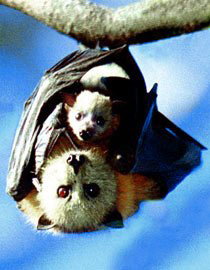Look! Up in the night sky! It's a bird! It's a bloodsucker! No, it is a beneficial friend, the bat!
 Bats have been around for about 50 million years and are among the earth's oldest animals: they also are some of the most misunderstood. Because they are nocturnal and strange looking, people have associated bats with evil things for centuries. Nothing could be further from the truth. In fact, bats play a very important role in the economic and environmental health of the world.
Bats have been around for about 50 million years and are among the earth's oldest animals: they also are some of the most misunderstood. Because they are nocturnal and strange looking, people have associated bats with evil things for centuries. Nothing could be further from the truth. In fact, bats play a very important role in the economic and environmental health of the world.
In rain forests and deserts, bats are some of the most important pollinators of plants. Without bat pollinators, the wild varieties of many foods we eat: avocados, bananas, cashews, mangoes and peaches couldn't grow.
Fruit eating bats spread seeds as they fly and digest. As natural insect controls, they can't be beat. One bat can eat up to 600 mosquitoes in one hour!
There are nearly 1000 species of bats worldwide, most of which live in tropical regions, like our very own Flying Foxes at The Oakland Zoo. Forty three species live in the US. In fact, almost a quarter of the world's mammals are bats! Bats are the only mammal that can fly and are in a special order called Chiroptera, which means "Hand wing." Bat wings are actually membranes of skin that stretch between their hands and legs. Bats give birth to helpless young and are breast fed milk by their mothers.
